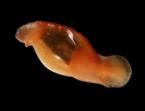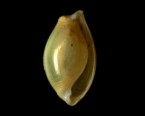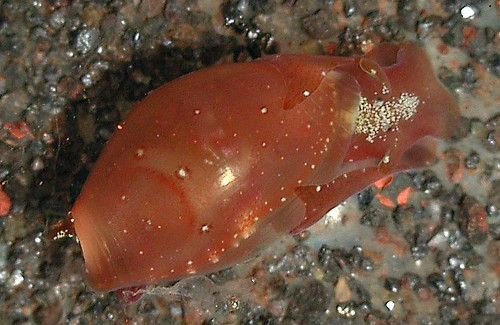| Home |
| Acknowledgments |
| Conventions |
| Glossary |
| Maps |
| References |
| Links |
| Articles |
| Thumbnails |
| Species
list |
| Family |
| Next
species |
Additional Photos

underside

young, 3.6 mm

shell
_______________
GALLERY

Vellicola muscarius (Gould, 1859)

| Maximum size: 6 mm. Identification: This species has a relatively thick, translucent-yellow shell with strongly developed spiral striae on its apex and base. The columella is white with a prominent fold. Mature animals are brick-red with scattered white spots. Immature animals have variably developed brick-red flecks and attenuate white rosettes. It may be distinguished from Vellicola sp. #13 by its thicker shell and prominent spiral striae. It may be distinguished from Vellicola sp. #15 by its brick-red color and attenuate rosettes. Natural history: Vellicola muscarius is a moderately rare species found in rocky habitats at depths of < 1 to 18 m (< 3 to 59 ft). It occurs at moderately protected to moderately exposed sites. Shells have also been found in sand samples from Halimeda kaneloana beds to depths of at least 52 m (170 ft). (Note 1) Distribution: Maui, Molokai, Oahu, Kauai, French Frigate Shoals and Midway. Probably widely distributed in the Indo-Pacific. Taxonomic notes: The shells of this species are very similar to the shells of Atys muscarius illustrated in Okotani's Marine Mollusks in Japan (2000). Atys tortuosa Reeve, 1878 may be a synonym. It's illustrated in Severns, 20ll as #10, plate 190 (misidentified in the caption as Hamineobulla kawamurai--caption switched with #8, plate 190: Vellicola muscarius). Shells are present in various mixed lots at the Bishop Museum. Photo: CP: 3.8 mm: Mala Wharf, Maui; July 22, 2005. Observations and comments: Note 1: Shells found in sand samples from Halimeda kaneloana beds are typically more strongly inflated than shells from animals found in rocky habitats. (see photo) Since we have yet to see live animals from the Halimeda kaneloana beds, there's some chance that they might ultimately turn out to be a second species. |
| Thumbnails |
Species
list |
Family | Next species | Top |